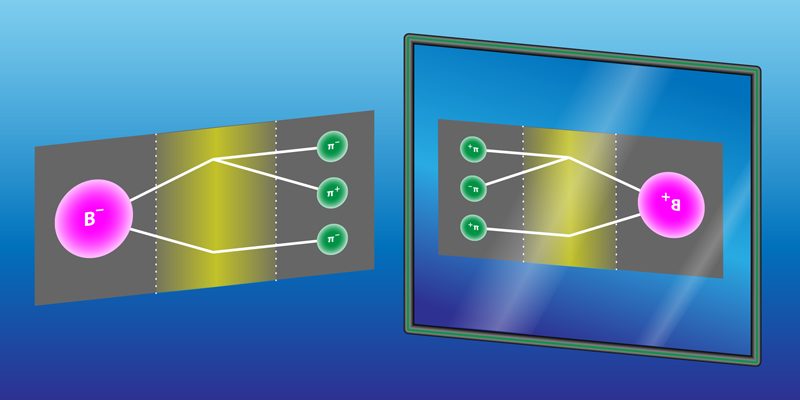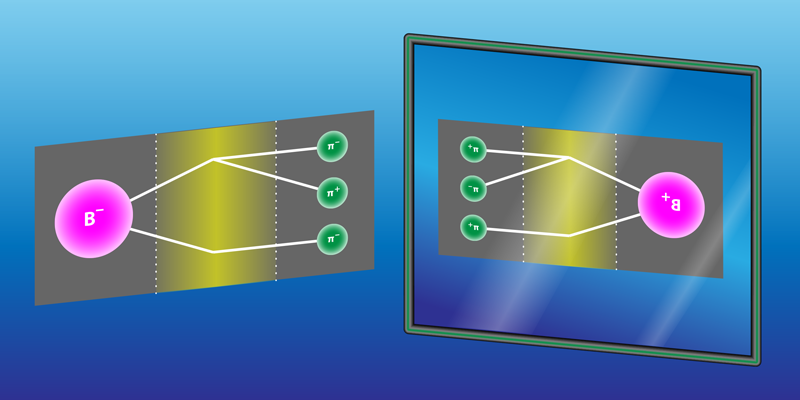CP Violations Newly Observed in Beauty Meson Decays
Physicists are engaged in a world-wide program of probing the intriguing, and rare, phenomenon of CP violation—a phenomenon needed to explain the dominance of matter over antimatter in the Universe [1]. As part of this program, the LHCb experiment at CERN reported in 2014 that the meson—a negatively charged particle containing a beauty (or bottom) quark—decays to three pions in a way that is different than how its antimatter counterpart, the meson, decays [2]. However, these measurements did not yield the sources of CP violation, which remained hidden—like a “diamond in the rough”—by all the complexities of strong force dynamics in these decays. With more than a fourfold increase in its data set, LHCb now reports three separate sources of CP violation within three-pion decays and provides key insights into the strong interaction dynamics [3]. Those insights may ultimately help determine if there is a new source of CP violation—one that goes beyond current models and can explain the matter-antimatter asymmetry of our Universe.
Violations of CP symmetry may sound like a breakdown in theory, but they are in fact an integral part of the standard model of particle physics. The C of CP refers to the “charge conjugation” operation in which every particle in a process is replaced by its antiparticle equivalent. The P refers to “parity transformation,” which inverts the spatial coordinates: . Processes associated with the strong and electromagnetic forces behave identically under C or P transformations. However, the weak interaction is not symmetric under C, P, or the combination CP (Fig. 1).
CP violation was first observed [4] in 1964 by James Cronin and Val Fitch and their collaborators at Brookhaven National Laboratory in New York, and it led to their 1980 Nobel Prize in Physics. The measurements showed a difference, or CP asymmetry, of 0.2% in the weak interaction decays of neutral K mesons, depending on whether they contained a strange quark or strange antiquark. In order to explain this matter-antimatter disparity, Japanese theorists Makoto Kobyashi and Toshihide Maskawa (KM) postulated in 1973 [5] that nature has six quarks, rather than the three known to exist at the time. The KM model assumes that the six quarks mix in such a way that strange-quark processes differ from strange-antiquark processes—thus explaining the observed CP violation in K mesons.
The KM theory also predicted large CP violation in some rare decays of particles containing beauty quarks, with CP asymmetries as high as 70%. By 2001, the BaBar experiment [6] at SLAC in California and the Belle experiment [7] at KEK in Japan observed the predicted CP violation in the decays of neutral B mesons and anti-B mesons decaying to the same final state. This led to the 2008 Nobel Prize in Physics for Kobyashi and Maskawa and the firm embedding of the KM theory within the standard model. However, the KM mechanism for producing CP violation was found to be several orders of magnitude too small to explain the matter domination in the Universe. Thus researchers have been on the lookout for sources of CP violation beyond the standard model.
This search for “extra” CP violation is an important motivation for LHCb, which studies the particles that stream out of high-energy proton-proton collisions at the Large Hadron Collider (LHC). The LHCb experiment consists of multiple particle detectors close to the axis of the LHC’s proton beam lines where B mesons, as well as other mesons containing charm quarks, are produced and quickly decay. With the enormous numbers of events being recorded, LHCb is sensitive to CP violation in very rare decays of both B and charm mesons. In fact, LHCb reported the first observation of CP violation in charm decays last year [8] (see Viewpoint: Charm Reflects Poorly on Anticharm).
When it comes to the three-pion decays of charged B mesons—written as and —CP violation is expected, but the exact amount is not well predicted. The uncertainty stems from the difficulty in calculating the strong interactions between the mesons. This strong interaction dynamics produces a range of different intermediate states (or decay modes), which each have a different CP asymmetry. Previous experiments, such as the BaBar experiment, have studied these three-pion decays and found features potentially related to CP violation [9]. However, because the process is so rare, BaBar did not have enough data to actually see the CP violation. With over 20,000 decays in hand, LHCb has 17 times the size of the BaBar experiment’s decay sample. That provides enough statistics to not only observe CP violating effects but to also test and validate models of the behavior of the strong interaction in these decays for the first time.
What the LHCb team observes is fascinating, as they are able to observe the different ways that B mesons can decay to three pions. For example, the B meson can initially decay into an intermediate state consisting of a single pion and a spin-1 rho meson ( ) with a mass of 770 MeV/ , which itself decays to a pair. This quasi-two-body decay is the dominant mode, accounting for 55% of the three-pion decays. LHCb also observed other modes, such as one where the pion pair comes through a spin-2 meson—called (1270)—with a mass of 1270 MeV/ , and another mode in which the pair exists in a spin-0 state with an effective mass below the rho mass (Fig. 2). The LHCb team used these results to determine the parameters that go into models of the strong interaction dynamics of this decay [10].
The collaboration observed CP violation—with a significance of more than 10 sigma—in two of the three-pion decay modes: the mode with (1270) exhibited a CP asymmetry of 40%, whereas the spin-0 decay mode had a 15% asymmetry. LHCb also established the presence of CP violation effects that it attributes to interference between the spin-0 and spin-1 states. However, the data showed no significant CP violation in the dominant decay mode with the spin-1 rho meson.
The LHCb observations of CP violation in these B meson decays are entirely consistent with predictions of the standard model . Consequently, this work doesn’t address the problem of the matter-dominated Universe. However, by providing experimental constraints and reliable models of the strong dynamics of charge-B-to-three-pion decays, these LHCb results can be used to reduce the uncertainties in the extraction of CP-violating observables in other related decays, such as decays of neutral B mesons to three pions ( and anti- ), which will be used to directly test the KM model with higher precision. With those reduced uncertainties, future precision measurements of such decays at LHCb or at the newly commissioned Belle II in Japan might uncover the most prized diamond in the rough: a new source of CP violation that lies beyond the standard model.
This research is published in Physical Review Letters and Physical Review D.
References
- A. D. Sakharov, “Violation of CP invariance, C asymmetry, and baryon asymmetry of the universe,” Usp. Fiz. Nauk 161, 61 (1991); Sov. Phys. Usp. 34, 392 (1991).
- R. Aaij et al. (LHCb Collaboration), “Measurement of CP violation in the phase space of and decays,” Phys. Rev. Lett. 112, 011801 (2014).
- R. Aaij et al. (LHCb Collaboration), “Observation of several sources of CP violation in decays,” Phys. Rev. Lett. 124, 031801 (2020).
- J. H. Christenson et al., “Evidence for the decay of the meson,” Phys. Rev. Lett. 13, 138 (1964).
- M. Kobayashi and T. Maskawa, “CP-violation in the renormalizable theory of weak interaction,” Prog. Theor. Phys. 49, 652 (1973).
- B. Aubert et al., “Observation of CP violation in the meson system,” Phys. Rev. Lett. 87, 091801 (2001).
- K. Abe et al. (Belle Collaboration), “Observation of large CP violation in the neutral B meson system,” Phys. Rev. Lett. 87, 091802 (2001).
- R. Aaij et al. (LHCb Collaboration), “Observation of CP violation in charm decays,” Phys. Rev. Lett. 122, 211803 (2019).
- B. Aubert et al. (BaBar Collaboration), “Dalitz plot analysis of decays,” Phys. Rev. D 79, 072006 (2009).
- R. Aaij et al. (LHCb Collaboration), “Amplitude analysis of the decay,” Phys. Rev. D 101, 012006 (2020).
- Y. Li et al., “Quasi-two-body decays in the perturbative QCD approach,” Phys. Rev. D 98, 056019 (2018).







